
The Académie Julian was a private art school for painting and sculpture founded in Paris, France, in 1867 by French painter and teacher Rodolphe Julian (1839–1907) that was active from 1868 through 1968. It remained famous for the number and quality of artists who attended during the great period of effervescence in the arts in the early twentieth century. After 1968, it integrated with ESAG Penninghen.

The 2nd arrondissement of Paris is one of the 20 arrondissements of the capital city of France. In spoken French, this arrondissement is colloquially referred to as deuxième. It is governed locally together with the 1st, 3rd and 4th arrondissement, with which it forms the 1st sector of Paris.
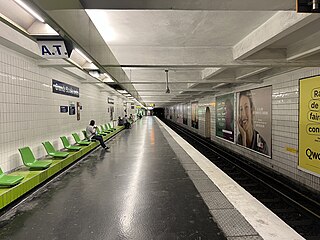
Grands Boulevards, formerly named Rue Montmartre (1931–1998), is a station on Lines 8 and 9 of the Paris Métro. In 2019, it was the 44th busiest station of the Métro network, with 6,807,424 yearly users.

The Musée Carnavalet in Paris is dedicated to the history of the city. The museum occupies two neighboring mansions: the Hôtel Carnavalet and the former Hôtel Le Peletier de Saint Fargeau. On the advice of Baron Haussmann, the civil servant who transformed Paris in the latter half of the 19th century, the Hôtel Carnavalet was purchased by the Municipal Council of Paris in 1866; it was opened to the public in 1880. By the latter part of the 20th century, the museum was full to capacity. The Hôtel Le Peletier de Saint Fargeau was annexed to the Carnavalet and opened to the public in 1989.

The following is a timeline of the history of the city of Paris, France.

The Boulevard du Temple, formerly nicknamed the "Boulevard du Crime", is a thoroughfare in Paris that separates the 3rd arrondissement from the 11th. It runs from the Place de la République to the Place Pasdeloup, and its name refers to the nearby Knights Templars' Temple, where they established their Paris priory.
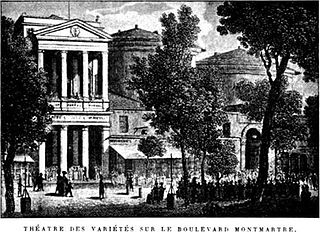
The Théâtre des Variétés is a theatre and "salle de spectacles" at 7–8, boulevard Montmartre, 2nd arrondissement, in Paris. It was declared a monument historique in 1974.

Marguerite Brunet, known by her stage name of Mademoiselle Montansier, was a French actress and theatre director.

The Boulevard Marguerite-de-Rochechouart is a street in Paris, France, situated at the foot of Montmartre and to its south. Like the neighbouring street, it is named after Marguerite de Rochechouart de Montpipeau (1665–1727), abbess of Montmartre. It is a result of the 1864 merging of the boulevards and chemins de ronde which followed the interior and exterior of the Wall of the Farmers-General. It has also been known as the boulevard des Poissonniers, chemin de ronde de Poissonnière and chemin de ronde de Rochechouart. It is served by the Paris Metro stations Pigalle, Anvers and Barbès – Rochechouart.

The Galerie Vivienne is one of the covered passages of Paris, France, located in the 2nd arrondissement. It is 176 metres (577 ft) long and 3 metres (9.8 ft) wide. The gallery has been registered as a historical monument since 7 July 1974.

The Passage Jouffroy is a covered passages of Paris, France, located in the 9th arrondissement. It runs between the Boulevard Montmartre to the south and the Rue de la Grange-Batelière to the north.
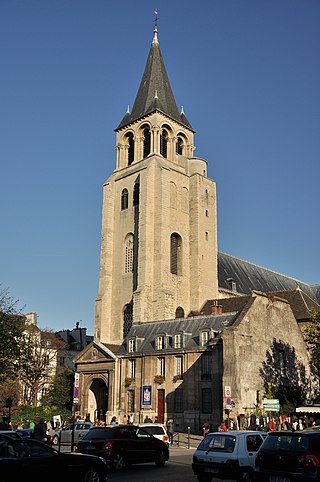
The city of Paris has notable examples of architecture of every period, from the Middle Ages to the 21st century. It was the birthplace of the Gothic style, and has important monuments of the French Renaissance, Classical revival, the Flamboyant style of the reign of Napoleon III, the Belle Époque, and the Art Nouveau style. The great Exposition Universelle (1889) and 1900 added Paris landmarks, including the Eiffel Tower and Grand Palais. In the 20th century, the Art Deco style of architecture first appeared in Paris, and Paris architects also influenced the postmodern architecture of the second half of the century.

The Boulevard Barbès is a boulevard in the 18th arrondissement of Paris. It is named after French politician Armand Barbès. It was built in 1867 during Haussmann's renovation of Paris. It starts at the boulevard de la Chapelle and ends at the rue Ordener. It is 835 metres long and 35 metres wide.

First Consul Napoleon Bonaparte moved into the Tuileries Palace on 19 February 1800 and immediately began to re-establish calm and order after the years of uncertainty and terror of the Revolution. He made peace with the Catholic Church; masses were held again in the Cathedral of Notre Dame, priests were allowed to wear ecclesiastical clothing again, and churches to ring their bells. To re-establish order in the unruly city, he abolished the elected position of the Mayor of Paris, and replaced it with a Prefect of the Seine and a Prefect of Police, both appointed by him. Each of the twelve arrondissements had its own mayor, but their power was limited to enforcing the decrees of Napoleon's ministers.

During the Restoration of the Bourbon monarchy (1815–1830) that followed the downfall of Napoleon, Paris was ruled by a royal government which tried to reverse many of the changes made to the city during the French Revolution. The city grew in population from 713,966 in 1817 to 785,866 in 1831. During the period Parisians saw the first public transport system, the first gas street lights, and the first uniformed Paris policemen. In July 1830, a popular uprising in the streets of Paris brought down the Bourbon monarchy and began reign of a constitutional monarch, Louis-Philippe.

Paris during the reign of King Louis-Philippe (1830-1848) was the city described in the novels of Honoré de Balzac and Victor Hugo. Its population increased from 785,000 in 1831 to 1,053,000 in 1848, as the city grew to the north and west, while the poorest neighborhoods in the center became even more crowded.

Paris in the Belle Époque was a period in the history of the city between the years 1871 to 1914, from the beginning of the Third French Republic until the First World War. It saw the construction of the Eiffel Tower, the Paris Métro, the completion of the Paris Opera, and the beginning of the Basilica of Sacré-Cœur on Montmartre. Three lavish "universal expositions" in 1878, 1889, and 1900 brought millions of visitors to Paris to sample the latest innovations in commerce, art, and technology. Paris was the scene of the first public projection of a motion picture, and the birthplace of the Ballets Russes, Impressionism, and Modern Art.
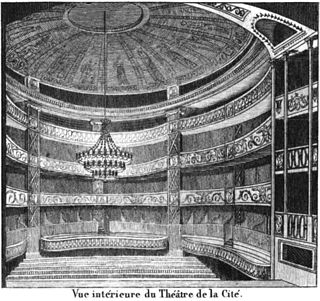
The Théâtre de la Cité-Variétés, also known simply as the Théâtre de la Cité, was an entertainment venue now demolished, located in the former rue Saint-Barthélemy, now the Boulevard du Palais, on the Île de la Cité in the modern 4th arrondissement of Paris. The theatre had a capacity of 1,800–2,000 spectators.

The Saint-Germain Cemetery or Saint-Pierre Cemetery was a rectangular cemetery in Paris, first attested in 1259 and used by Protestants from 1598 to 1604 onwards. It was sited in the north-west corner of the former rue Taranne and rue des Saints-Pères, alongside the chapelle des Saint-Pères (on the site now occupied by square de la Charité at 186 boulevard Saint-Germain. It measured 27 toise by 8 toise. Its site is now covered by Square Taras-Chevtchenko.
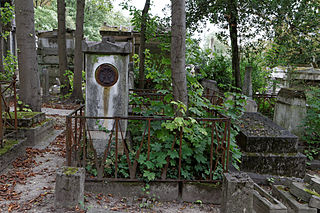
Jacques Cellerier (1742–1814) was a French architect in the neoclassical style whose buildings can be seen mainly in Paris and Dijon.




















